Thread Rating:
- Minor starts at $20 and must hit by $50.
- Major starts at $350 and must hit by $400.
- Meter increase based on amount bet (you may recall WMS slots are by amount won).
- I ran through $66 and the minor jackpot went up 30 cents, and the major 13 cents.
- After rounding, let's assuming the rate of increase on the minor is 0.0045, and on the major is 0.0020.
Much like my table for the WMS game, here is my table for the target point for the major jackpot, according to the total return of the game and value of the minor jackpot.
| Minor | 14% | 12% | 10% | 8% | 6% |
|---|---|---|---|---|---|
| $25 | $395.51 | $394.94 | $394.20 | $393.22 | $391.84 |
| $26 | $395.50 | $394.92 | $394.19 | $393.20 | $391.81 |
| $27 | $395.49 | $394.91 | $394.17 | $393.18 | $391.77 |
| $28 | $395.47 | $394.90 | $394.15 | $393.15 | $391.73 |
| $29 | $395.46 | $394.88 | $394.13 | $393.12 | $391.69 |
| $30 | $395.45 | $394.86 | $394.11 | $393.09 | $391.64 |
| $31 | $395.43 | $394.84 | $394.08 | $393.05 | $391.59 |
| $32 | $395.42 | $394.82 | $394.05 | $393.01 | $391.53 |
| $33 | $395.40 | $394.80 | $394.02 | $392.97 | $391.47 |
| $34 | $395.37 | $394.77 | $393.98 | $392.92 | $391.39 |
| $35 | $395.35 | $394.74 | $393.94 | $392.86 | $391.30 |
| $36 | $395.32 | $394.70 | $393.89 | $392.79 | $391.20 |
| $37 | $395.29 | $394.66 | $393.83 | $392.71 | $391.08 |
| $38 | $395.25 | $394.60 | $393.76 | $392.61 | $390.93 |
| $39 | $395.20 | $394.54 | $393.68 | $392.49 | $390.76 |
| $40 | $395.14 | $394.46 | $393.57 | $392.34 | $390.53 |
| $41 | $395.06 | $394.37 | $393.44 | $392.16 | $390.24 |
| $42 | $394.96 | $394.24 | $393.27 | $391.91 | $389.86 |
| $43 | $394.83 | $394.07 | $393.03 | $391.57 | $389.31 |
| $44 | $394.65 | $393.82 | $392.69 | $391.06 | $388.49 |
| $45 | $394.37 | $393.44 | $392.16 | $390.24 | $387.10 |
| $46 | $393.88 | $392.78 | $391.18 | $388.69 | $384.24 |
| $47 | $392.86 | $391.30 | $388.89 | $384.62 | $375.00 |
Here is the same thing for the minor jackpot, based on the return and the major jackpot amount.
| Major | 14% | 12% | 10% | 8% | 6% |
|---|---|---|---|---|---|
| $350 | $48.68 | $48.51 | $48.28 | $47.97 | $47.53 |
| $352 | $48.68 | $48.50 | $48.27 | $47.96 | $47.51 |
| $354 | $48.67 | $48.50 | $48.26 | $47.95 | $47.49 |
| $356 | $48.67 | $48.49 | $48.25 | $47.93 | $47.47 |
| $358 | $48.66 | $48.48 | $48.24 | $47.92 | $47.44 |
| $360 | $48.65 | $48.47 | $48.23 | $47.90 | $47.41 |
| $362 | $48.64 | $48.46 | $48.21 | $47.88 | $47.38 |
| $364 | $48.63 | $48.45 | $48.20 | $47.85 | $47.35 |
| $366 | $48.62 | $48.43 | $48.18 | $47.83 | $47.30 |
| $368 | $48.61 | $48.42 | $48.16 | $47.79 | $47.26 |
| $370 | $48.60 | $48.40 | $48.13 | $47.76 | $47.20 |
| $372 | $48.58 | $48.37 | $48.10 | $47.71 | $47.13 |
| $374 | $48.56 | $48.35 | $48.06 | $47.66 | $47.05 |
| $376 | $48.54 | $48.32 | $48.02 | $47.60 | $46.95 |
| $378 | $48.51 | $48.28 | $47.97 | $47.52 | $46.81 |
| $380 | $48.47 | $48.23 | $47.90 | $47.41 | $46.64 |
| $382 | $48.42 | $48.16 | $47.81 | $47.27 | $46.40 |
| $384 | $48.36 | $48.08 | $47.68 | $47.08 | $46.05 |
| $386 | $48.27 | $47.95 | $47.50 | $46.78 | $45.49 |
| $388 | $48.13 | $47.76 | $47.20 | $46.27 | $44.42 |
| $390 | $47.90 | $47.41 | $46.64 | $45.21 | $41.67 |
| $392 | $47.41 | $46.64 | $45.21 | $41.67 |
Sorry, no pictures because my camera battery was dead. I'm happy to say that while I was playing to determine the meter rise I HIT the minor jackpot for $23.36. It is the first time I have won a mystery jackpot.
Q: Why don't cannibals eat clowns?
I'm surprised the travel on the major jackpot is so short. Seed is $350, must-hit is $400? Is that designed to avoid the obviously +EV situation with the WMS games? Like, this is $390 - is that a good deal? I don't know. But if the WMS version is $490, I'm sitting down...
Quote: rdw4potusI'm surprised the travel on the major jackpot is so short. Seed is $350, must-hit is $400? Is that designed to avoid the obviously +EV situation with the WMS games? Like, this is $390 - is that a good deal?
I also wonder why there is such a small spread on the Major jackpot. I tend to think they think that recreational players will see a jackpot of $375 and think, "Wow, that is only $25 from the must hit point." However, the rate of increase is so slow that it is still hard to hit that close.
All things considered, I think the Target Point on the minor should be $48, and on the major $393.
They also have the 250-500, 25-50 ones that were first talked about.
Quote: WizardAll things considered, I think the Target Point on the minor should be $48, and on the major $393.
Those are both so much higher than most would people would likely guess. That must be why must hit progressive's seem to be increasing. My local casino has a 12 machine carousel that I posted about before with a must hit by $20,000 (starts at $1000) that I posted about previously. I did a little tracking on how fast the counter moves when it got over $19,000 recently and with a full carousel it was averaging about $100 an hour. The math didn't seem to work to make it + EV until about $19,600.
Quote: WizardI worked for hours on the post above and was hoping to get a reply. Sometimes if a new thread doesn't gain instant interest doesn't make the first page of the "most recent posts" and gets forgotten. So, I'd like tell a joke to give it another chance.
Q: Why don't cannibals eat clowns?Because clowns taste funny.
To be honest I am interested in the analysis but really don't know what to make of this. I tried reading the slot returns pdf but all that math just kinda turned me off to it, even though I am looking at progressive slots as another tool in the arsenal. Should I pick up Peter Liston's book to get a more layman's term of slots?
BTW I would hate to be a clown. Kids hate you, you're lower on the entertainment factor then mimes, and cannibals won't even touch you. I'm sure this movie didn't help neither.
Quote: dwheatleyThere's a horse track with slots near my house that just introduced a range of mystery jackpots. Some of the majors go from 400-500, and then in the high limit room there's a bank with majors from 9000-10000. Next time I'm there I'll try to jot down the manufacturer and ranges for all the machines.
They also have the 250-500, 25-50 ones that were first talked about.
Sounds like Ainsworth dollar machines, but you probably meant 350-500. Mustang Money 2 is one of the games you might have seen with 3 wild horse symbols on reel 2,3,4 triggering the bonus. It's a good game to play 1 line reasonably well for entertainment's sake with a small sliver of a chance for a good multiple.
Quote: onenickelmiracleSounds like Ainsworth dollar machines, but you probably meant 350-500. Mustang Money 2 is one of the games you might have seen with 3 wild horse symbols on reel 2,3,4 triggering the bonus. It's a good game to play 1 line reasonably well for entertainment's sake with a small sliver of a chance for a good multiple.
My notes said $350-$400 but I will try to swing by the Red Rock this evening to verify and take some pictures. The least you can bet is 50-cents, covering 50 lines at 1-cent each.
Quote: WizardMy notes said $350-$400 but I will try to swing by the Red Rock this evening to verify and take some pictures. The least you can bet is 50-cents, covering 50 lines at 1-cent each.
You're right. I just commented on the dollar progressives the other man was mentioning by Ainsworth. Ainsworth dollar progressives have minors $350-$500 and majors $9000-$10,000.
Quote: WizardI was at the Red Rock today and saw some more mystery progressive slots. This time they were by a company called Ainsworth. Here is what I can tell you.
- Minor starts at $20 and must hit by $50.
- Major starts at $350 and must hit by $400.
- Meter increase based on amount bet (you may recall WMS slots are by amount won).
- I ran through $66 and the minor jackpot went up 30 cents, and the major 13 cents.
- After rounding, let's assuming the rate of increase on the minor is 0.0045, and on the major is 0.0020.
Thanks for the work, Wizard - sorry I missed this yesterday!
You are right on with the specs of the game. This matches exactly (including rate of increase) what I have observed on one of Ainsworth's penny versions. The other was $30 to $50 at 0.30% and $170 to $200 at 0.25%. One could verify the meter rise by noting the increase in each meter for every $20 bet - you should get the same result each time. I prefer to play until both roll over on the same bet, then start my $20 session(s). (Note: $20 increments don't work for all brands!) If you want to see more specs, I have listed some others in the Wizard's first thread entitled "Mystery Progressives."
In addition to the $10,000/$500 $1 version, I have also seen one with a Major that goes from $4K to $5K but I don't recall the Minor, nor did I rate any of these meters. Saw these at Atlantis Reno - the larger in the High Limit area and the "smaller" in a carousel near the Players Club.
Some questions for the Wizard: As for your analysis, is it safe to assume that you adjusted for the value of the return given by the meters as you did with the WMS "by bet" games? imHo, it seems to me an unnecessary complexity, as we are estimating the total return of the base game anyway. Couldn't we instead estimate the base return and use the simpler formula given by Kneeland to calculate the OPN? Conversely, if we determine the return of the base game using the deconstruction techniques that you have demonstrated on WoO for slots, then couldn't we again use this simpler formula? Also, what is your method for determining the two-meter problem? Are you adjusting the single-meter equation for one meter by allowing for the return of the "other" meter, or are you starting from scratch with an equation in two unknowns and taking the derivative with respect to each? ...Or some other method? As always, I appreciate the websites and your time!
Quote: camaplI prefer to play until both roll over on the same bet, then start my $20 session(s).
I agree that one should start keeping track right after a meter increase, preferably when both go up. When I played earlier this week I started keeping track at an arbitrary point, so I don't know how far I was from the next penny increase.
Quote:Some questions for the Wizard: As for your analysis, is it safe to assume that you adjusted for the value of the return given by the meters as you did with the WMS "by bet" games? imHo, it seems to me an unnecessary complexity, as we are estimating the total return of the base game anyway. Couldn't we instead estimate the base return and use the simpler formula given by Kneeland to calculate the OPN? Conversely, if we determine the return of the base game using the deconstruction techniques that you have demonstrated on WoO for slots, then couldn't we again use this simpler formula? Also, what is your method for determining the two-meter problem? Are you adjusting the single-meter equation for one meter by allowing for the return of the "other" meter, or are you starting from scratch with an equation in two unknowns and taking the derivative with respect to each? ...Or some other method? As always, I appreciate the websites and your time!
I include the value of the progressives in the total return of the table. The Kneeland formula is simpler, and is based on just the fixed awards of the game.
Here is my formula for the Target Point (TP)
TP = (max jackpot) * [1 - (fixed return) - (value of other jackpot) / [ 1 - (fixed return) - (value of other jackpot) + rate of increase ]
It is more complicated on the WMS games, since the rate of increase is based on wins, not bet.
To get the "fixed return" I take the assumed total return and subtract out the value of the jackpots. I assume the value of the jackpots to be the meter rise + 2 * (minimum win) * (meter rise)/[(max win)-(min win)].
Quote: onenickelmiracleYou're right. I just commented on the dollar progressives the other man was mentioning by Ainsworth. Ainsworth dollar progressives have minors $350-$500 and majors $9000-$10,000.
Man, how much coin in per hour would one spend on these, if one was holding a machine hostage because of a high meter? I can imagine someone (or partners) doing so at some point for that much money.
I've seen people on $500 major must- hit-by for at least 8 or more hours trying to hit it.
Quote: rxwineMan, how much coin in per hour would one spend on these, if one was holding a machine hostage because of a high meter? I can imagine someone (or partners) doing so at some point for that much money.
I've seen people on $500 major must- hit-by for at least 8 or more hours trying to hit it.
These machines are everywhere here in southern California. It's not uncommon to see a hispanic family pooling money together to play a machine with a meter at $388, must hit by $400. The sad part is to come back later and someone completely different (preferably me) is playing the same machine with a meter at $398.
Quote: rxwineMan, how much coin in per hour would one spend on these, if one was holding a machine hostage because of a high meter? I can imagine someone (or partners) doing so at some point for that much money.
I've seen people on $500 major must- hit-by for at least 8 or more hours trying to hit it.
The story as I was told, 2 days and $20,000 lost to win somewhere between $9900 and $10,000(class II VLT). I'm sure there must have been some machine holding for them by the casino or something, but I don't know if the Mountaineer does that. At one point, they lost check cashing privileges at the casino and had to drive home an hour to get more money. I think every $5 bet makes one side go up a penny at WV, but I think it was more generous at Seneca Niagara(class III). It's been a while since Seneca, so I don't remember if they are the same or not. Borgata has(had?) these if anyone goes there.
Quote: WizardHere is my formula for the Target Point (TP)
TP = (max jackpot) * [1 - (fixed return) - (value of other jackpot) / [ 1 - (fixed return) - (value of other jackpot) + rate of increase ]
For what it's worth, that is the method that I have been using for two or more meters. In some cases, I also subtract (from 1) the return from the player's club. Usually during a heavy points multiplier if I know the meter will pay off before the multiplier expires. I usually prefer to think in terms of expected profit for such a play, but for those who like to know the expected return of a play, the return of this play is 100% plus Adjusted Hold plus Meter Rate. Hopefully, this is high enough to cover our estimate of the total or fixed return of the slot as well as the variance. The higher the hold of the game, the longer you should wait to play, but the more you expect make each time! (Let's just hope you can find a seat! lol)
Note that unlike playing towards a open-ended progressive, such as a Royal Flush or hitting 8 out of 8 in keno, the Target Point is not the breakeven point of the meter(s) with the base game.
Quote:To get the "fixed return" I take the assumed total return and subtract out the value of the jackpots. I assume the value of the jackpots to be the meter rise + 2 * (minimum win) * (meter rise)/[(max win)-(min win)].
I haven't tweaked to verify if your formula and mine are algebraically equal, but the formula that I use for the return from any "Must Hit By" meter is [Rate * (Max + Min) / (Max - Min)] which is simply the amount I expect to win from the meter [(Max + Min) / 2] divided by expected total bets while playing the base game {[(Max - Min) / 2] / Rate}. This assumes a uniform distribution across the entire range of the meter(s).
The formulae above are for the return of the meter from reset. For the current return, substitute the meter's current value for Min.
Quote: onenickelmiracleSounds like Ainsworth dollar machines, but you probably meant 350-500. Mustang Money 2 is one of the games you might have seen with 3 wild horse symbols on reel 2,3,4 triggering the bonus. It's a good game to play 1 line reasonably well for entertainment's sake with a small sliver of a chance for a good multiple.
Okay, I hope the following pictures remove all doubt about the starting and "must hit by" points for the Ainsworth games, at least the bank at the Red Rock. Click on any image for a larger version.
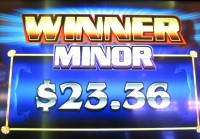
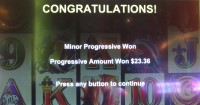
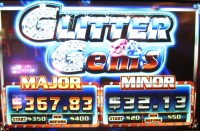
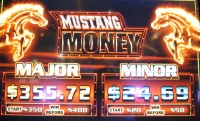
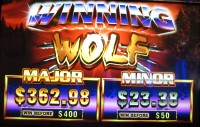
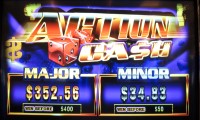
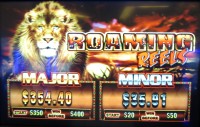
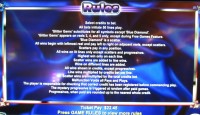
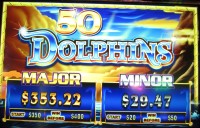
Quote: onenickelmiracleThe only error I saw was the Minor target point, with 6% HE, Major at $392, listing the target point at $17.86. I assumed this would mean play it at any number with $17 being below the range.
Thanks. That one was already positive with the major at $392, so the formula wasn't applicable any longer, and gave a nonsense result. I just corrected it.
In my town we have many of these types of progressive jackpots. They have a ceiling and the jackpot is guaranteed to hit before the ceiling is reached.
Assuming the machine has an RTP of 87.5%
The progressive jackpot has a ceiling of $100
You need to wager $1.40 to move the progressive jackpot by 1c
This would mean that 0.7% of the machines RTP goes into the progressive jackpot making the machine’s RTP 86.8%
So every for $100 you wager you expect back $86.8 and you move the meter by ~71.43c (or more precisely 71.42857142857143c)
Therefore it costs $13.20 to move the meter by ~71.43c
What I want to find is the breakeven point for these types of progressive jackpots.
Can anyone show me the formula to work them out?
EDIT: Don't worry I found it.
100/13.2=7.575757575757576
71.42857142857143*7.575757575757576=541.1255411255412
10000-541.1255411255412=9458.874458874459
So the breakeven point for this particular progressive jackpot is ~$94.59
EDIT 2: but the breakeven point is not quite accurate as I did not take into account the original starting point for the mystery progressive jackpot. In this case the mystery progressive jackpot starts at $50.
Quote: mjkaraaQuestion for the Wizard: Regarding the equation for calculating the Target Point for Ainsworth/WMS mystery jackpots, how does the value of the current major or minor jackpot plug into that equation? For example, the chart above shows different Target Points based on the major/minor JP value in the left column, but I don't see where that current JP value plugs into the equation t = m × (h + r) / (h + 2r). I apologize if I'm overlooking something obvious, but I'm trying to use that equation to calculate my own chart for the $1 Ainsworth machines with major JPs from $9000 to $10000, and minor JPs from $350 to $500. BTW, it's my first time posting on your site, and I'm a big fan! Thank you.
Welcome to the forum, mj, and thanks for the tough question (tough for me, anyway). Hope some of the great minds here can help with that.
Glad you enjoy the sites!
Quote: mjkaraaQuestion for the Wizard: Regarding the equation for calculating the Target Point for Ainsworth/WMS mystery jackpots, how does the value of the current major or minor jackpot plug into that equation? For example, the chart above shows different Target Points based on the major/minor JP value in the left column, but I don't see where that current JP value plugs into the equation t = m × (h + r) / (h + 2r). I apologize if I'm overlooking something obvious, but I'm trying to use that equation to calculate my own chart for the $1 Ainsworth machines with major JPs from $9000 to $10000, and minor JPs from $350 to $500. BTW, it's my first time posting on your site, and I'm a big fan! Thank you.
Hi, I play a lot of these machines.
That equation is to calculate the target point: at what size the jackpot becomes +EV for the player (assuming a uniform distribution). This target point does not depend on the current size of the jackpot, so it is not a parameter you need to include in the equation. You would calculate the target point using that equation and then play the jackpot if it is at least as big as the target point, basically
Quote: WizardI just wrote a page on the *no link allowed* (ainsworth games). It is the same information I already put here, but I welcome all comments anyway.
Thank you for the informative post. I see that you assumed a uniform distribution of jackpot hit points, can I ask what this is based on? I have collected a lot of data on similar machines around the world and have found that many do not conform to a uniform distribution.
Quote: TreeI see that you assumed a uniform distribution of jackpot hit points, can I ask what this is based on? I have collected a lot of data on similar machines around the world and have found that many do not conform to a uniform distribution.
It is based on the book Million Dollar Slots by Peter Liston, as well as a presentation he delivered, that I attended. He allegedly made (and I have no reason to doubt it) over a million dollars playing mystery progressives in Australia. However, I've been hearing some credible evidence some makers have an almost zero chance of hitting the jackpot until it gets close to the "must hit by" point.
I don't have enough evidence to make any specific accusations at this point. I wish I did.
Quote: WizardIt is based on the book Million Dollar Slots by Peter Liston, as well as a presentation he delivered, that I attended. He allegedly made (and I have no reason to doubt it) over a million dollars playing mystery progressives in Australia. However, I've been hearing some credible evidence some makers have an almost zero chance of hitting the jackpot until it gets close to the "must hit by" point.
I don't have enough evidence to make any specific accusations at this point. I wish I did.
I understand. I have personally seen the whole mix: progressives that are uniform, as well as those that are biased towards specific points in the distribution, not always going late. I personally feel uncomfortable assuming a uniform distribution these days
Quote: TreeI personally feel uncomfortable assuming a uniform distribution these days
Neither do I. I should update my page about them to say as such.
Quote: WizardNeither do I. I should update my page about them to say as such.
Should that be "As do I"?
Quote: MaxPenShould that be "As do I"?
You're probably right. I was focusing on the "un" in your statement, thus used the negative "neither." However, I should probably be in unity with "feel."
I am interested in the same thing. i tried to used the formula t = m × (h + r) / (h + 2r)but i did not get the same target point as the chart indicate i am confused . $400 * (6%+0.2%)/ ( 6% +2*0.2%) ...I got something like $ 384 which is way off compared to the chart which said something around $ 391 as the target pointQuote: mjkaraaQuestion for the Wizard: Regarding the equation for calculating the Target Point for Ainsworth/WMS mystery jackpots, how does the value of the current major or minor jackpot plug into that equation? For example, the chart above shows different Target Points based on the major/minor JP value in the left column, but I don't see where that current JP value plugs into the equation t = m × (h + r) / (h + 2r). I apologize if I'm overlooking something obvious, but I'm trying to use that equation to calculate my own chart for the $1 Ainsworth machines with major JPs from $9000 to $10000, and minor JPs from $350 to $500. BTW, it's my first time posting on your site, and I'm a big fan! Thank you.
1.) "Rumble Rumble Ainsworth" Major must hit by $5,000, Minor by $500. Starting points= $4,500 Major/ $250 Minor (I believe this is standard).
2.) Both meters are $5 played= 1 cent increase
3.) RTP is 90% (or house edge is 10%). Again, I know this high, but just using a round number to simplify the equation. Thank you!
Quote: SgI GUESS the people that know anything wants everybody else to be confused and don"t know what they are doing so they can ultimately benefit
Not exactly. There are members here who do make a living by finding weaknesses in games casinos offer, and are fearful that publicizing them will result in the advantages being stopped by said casinos. This example I do not believe to be one of them. Must hit progressives set a payback that favors the casino even including the jackpot. Early players do subsidize late players, the casino does not.
People here have lives and jobs and don't always get to every question immediately.
Welcome back to the forum sg. Try and have a little patience.


